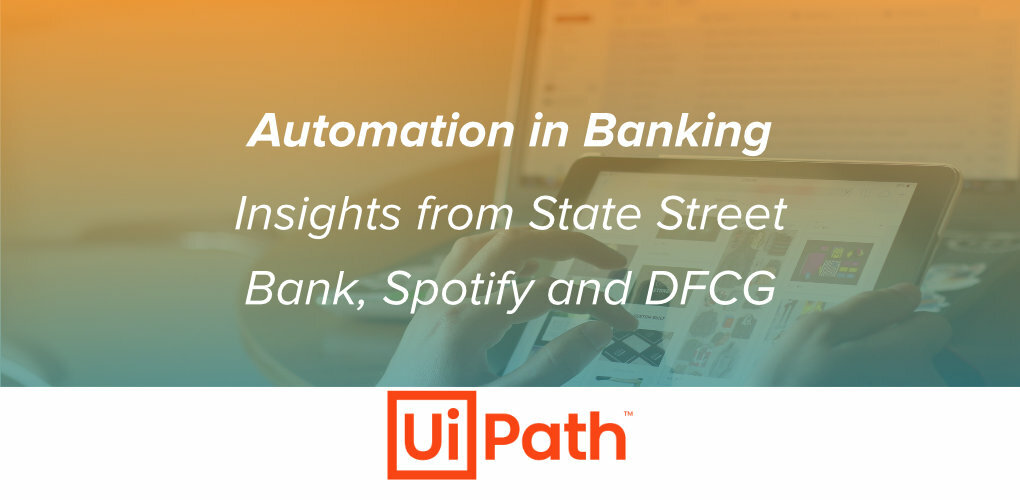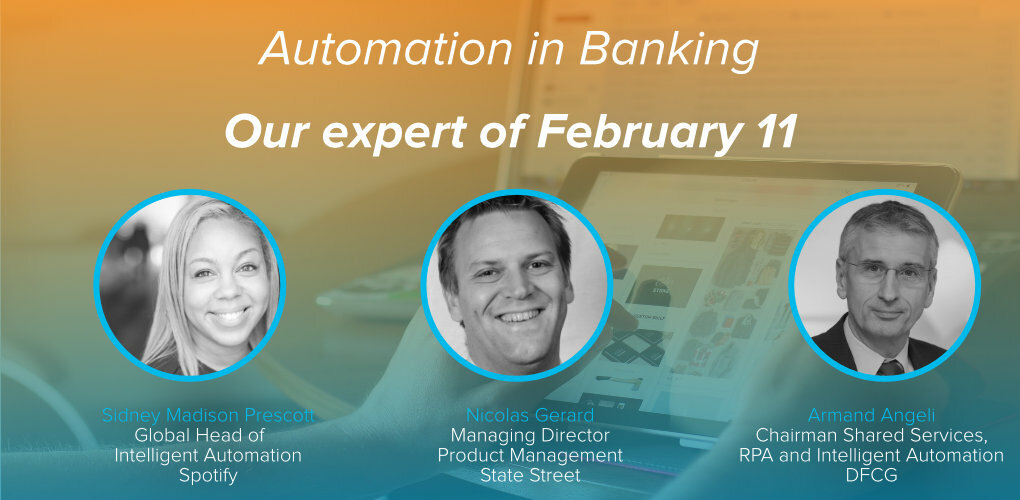
Insights & Opinions
Automation in Banking: insights from State Street Bank, Spotify and DFCG
Tue, 16 Feb 2021


"Automation started mainly with banks and insurance companies because they have loads of people doing the same thing, and they have loads of manual processes," said Armand Angeli during The Banking Scene Afterwork of February 11, kindly sponsored by UiPath.
Despite the increased awareness of automation, RPA (Robotics Process Automation) and Intelligent Automation, all this often remains a black box for many people working in financial services. The following excellent panel of wise provided a couple of helpful tips & tricks to achieving the best results with automation in banking:
- Sidney Madison Prescott, VP Intelligent Automation at Spotify, co-author of "Robotic Process Automation using UiPath StudioX"
- Nicolas Gerard, Managing Director Product Management of State Street Bank
- Armand Angeli, Chairman of RPA, Intelligent Automation, Shared Services and Outsourcing at DFCG, the French Centre of CFOs

In short, these are the three main advises to keep in mind:
- Realise who your stakeholders are, involve your leadership from the beginning
- Automation is an iterative process, start piece by piece
- Look at the right business metrics
Realise who your stakeholders are
Similar to any transformational project, stakeholder management is the Holy Grail for success. Sidney rightfully explained that "a very big part of whether or not you can be successful is understanding the message and how you're going to frame this conversation, both to leadership and your employees."
It requires a lot of research to understand your company's inefficiencies, to find where most gains can be obtained in terms of optimisations, and ideas to solve those challenges. Avoid silo thinking: talk to the employees, collaborate to find these inefficiencies and convince them about the value of automation.
"Be very transparent with your compliance team, your security team, cybersecurity team, and specifically in relation to the vendors that you're going to engage with for these different components to build out your RPA and Intelligent Automation tool stack", Sidney explained, "build the same transparency in relation to how you're going to ensure that the policies, the controls that are in place within the organisation today, are not going to be negatively impacted by this new technology."
Create a roadmap and start with a simple proof of concept that can help the organisation understand the value of RPA. "Talking about RPA is very simple. But because it's very simple, sometimes you can fail, if you don't have proper governance, if you don't have a vision about the journey. So it does work very well, but first, think before you jump into it", explained Armand.
Nicolas experienced the same at State Street Bank: "We started with a bottom-up approach. We went to the users, the actual operators of a given task and asked them what it is that they keep on doing that eats a lot of their time, but doesn't add any value or where they do not add any value? Where can we automate some processes?"
They first created a list of processes ready for automation, they then educated the people about what RPA essentially is, and where the business case is found.
This comes with an understanding of where RPA should not be implemented, Nicolas explains: "I see robotics as the bridge between manual operations and core systems. RPA should not touch your core systems. We are a bank, and we are fully integrated with SWIFT messages. RPA doesn't have its place over there. So it's the in-between world where we saw the biggest opportunities. Clearly, we were filling out a lot of forms manually. So that's where we started."
He added that the leadership must be involved in the project from the very beginning: "Your leadership needs to make the strategic choices because what the business says when they come up with ideas may not fit the strategy. There may be other plans for a given process. There may be other development plans for your core, IT infrastructure."
Start small, keep it understandable
In her many observations, Sidney witnessed that businesses at the start of their automation projects, first look at RPA, because it is a pure rule-based, structured technology, easy to understand by human beings.
Sidney: "Looking at the very manual, repetitive tasks, I think it's very easy for an organisation's executive side to understand that it's inefficient to have a large number of manual processes. But once you get that by, you can then ramp up slowly, but surely. Get your metadata and your data in order and structured in such a way to then make it more feasible to start branching into the Intelligent Automation, hyperautomation."
In this respect, Finance and Compliance were the departments where our special guests believed they would achieve the most significant gains, because of the many manual, yet critical processes that are very rule-based.
Armand: "RPA is mimicking or emulating what someone does on their keyboard. It's like a macro, it's a dumb, stupid macro, replicating what the person is doing on his or her keyboard. After that, what you want is to automate a full activity or a complete process. You have to bring into your macro more intelligent tools."
These more intelligent tools are in a first phase, what we call cognitive RPA, tools and solutions that leverage Artificial Intelligence (AI) technologies such as Optical Character Recognition (OCR), Text Analytics, and Machine Learning to improve your workforce's experience and customers, according to Gartner.
Only after an organisation completely understands the ins and outs of RPA, it is wise to start looking at Intelligent Automation where more tools are added, like machine learning. Hyperautomation goes one step further, adding more tools to optimise entire customer journeys.
Even within Intelligent Automation, Sidney believes in the low hanging fruit in Finance: "They have a large amount of documentation and kind of parsing of the data within that documentation that is done by humans today, unstructured data that we can basically extract either through out-of-the-box machine learning models, or create our own, and translate that language into something more readable for a bot to intake. So it's, I think it's the same wheelhouse, and you get the same opportunities."
Armand added that: "The CFOs tend to be the pilot or the co-pilot of the full transformation of the company. And they are most of the time involved in automating the entire company actually, helping the CEO."
Look at the right business metrics
The best way to convince your leadership is by showing the actual results of automation. Let us be clear: this is not a pure cost-cutting exercise and in some cases, not a cost-cutting exercise at all!
Automating your processes will equally:
- Mitigate your risks and eliminate human errors
- Engage your workforce: allow your employees to work on value-adding activities for the organisation
- Make happy customers: improve your customer experience
- Generate new revenues: increase sales or develop new products
Sidney: "You don't ever want to think of RPA as a standalone technology stack that is going to save the world. Think about how can RPA fit and amplify my ability to deliver, whether that's a better customer experience, again, whether that's more compliance, better data quality and governance?"
Intelligent automation can help a bank with online customer onboarding, optimise KYC, open bank accounts, and validate new or existing clients… but it can go much further. Intelligent automation will translate unstructured into structured information, resulting in a lot more valuable data. In turn, more granular insights on your customers may generate higher sales, or more customer satisfaction, as Armand explained. In some cases, it even ends up in new product development, like at State Street.
A first example Nicolas gave is an artificial intelligence solution used to monitor regulatory obligations and the services they are now considering to open up to clients.
The second example is a direct result of their role as a custodian: "We are the safe keeper of our clients' assets. But now, more and more, we are the safe keeper of the data. Obviously, within all the guidelines and respect of privacy, and this is key, we can leverage that data to build new services, new indices, like for example, on gender diversity." They are now investigating how this can help them to scan a given portfolio on specific ESG characteristics.
Conclusion
After 2 expert sessions with UiPath, it was great to have testimonials from the industry explaining their experience. Automation can be complicated, as these stories show. They also demonstrate the value of automation in the various supply chains and processes within a bank.
Make sure you free your agenda on September 9th, when we welcome Chris Skinner, author and commentator at The Finanser and Nitin Purwar, Director Banking Industry Practice at UiPath to discuss "Automation for Good: Automation as an enabler for ESG and Sustainability in Banks."
Would you like to attend one of our Afterwork sessions as well? Have a look at our program: The Banking Scene - Afterwork
